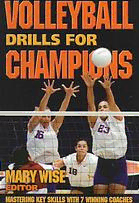Table Of ContentPage i
Volleyball Drills for Champions
Mary Wise
University of Florida
Editor
Human Kinetics
Page ii
Library of Congress CataloginginPublication Data
Volleyball drills for champions / Mary Wise, editor
p. cm.
ISBN 0880117788
1. Volleyball—Training. 2. Volleyball—Coaching. I. Wise,
Mary, 1959
GV1015.5.I73V65 1999
796.325—dc21 9848884
CIP
Copyright © 1999 by Mary Wise
All rights reserved. Except for use in a review, the reproduction or utilization of this work in any form or by any electronic, mechanical, or other means, now known or
hereafter invented. including xerography, photocopying, and recording, and in any information storage and retrieval system, is forbidden without the written permission
of the publisher.
Acquisitions Editor: Ken Mange; Developmental Editor: C.E. Petit, JD; Assistant Editors: Cassandra Mitchell and Leigh LaHood; Copyeditor: Joyce Sexton;
Proofreader: Erin Cler; Graphic Designer: Robert Reuther; Graphic Artist: Brian McElwain; Photo Editor: Boyd LaFoon; Cover Designer: Jack Davis;
Photographer (cover): Courtesy of University of Florida; Illustrator: Joe Bellis and Sharon Smith; Printer: Versa Press
Printed in the United States of America
10 9 8 7 6 5 4 3 2 1
Human Kinetics
Web site: http://www.humankinetics.com/
United States: Human Kinetics, P.O. Box 5076, Champaign, IL 618255076
18007474457
email: [email protected]
Canada: Human Kinetics, 475 Devonshire Road Unit 100, Windsor, ON N8Y 2L5
18004657301 (in Canada only)
email: [email protected]
Europe: Human Kinetics, P.O. Box IW14, Leeds LS16 6TR, United Kingdom
(44) 1132 781708
email: [email protected]
Australia: Human Kinetics, 57A Price Avenue, Lower Mitcham, South Australia 5062
(088) 277 1555
email: [email protected]
New Zealand: Human Kinetics, P.O. Box 105231, Auckland 1
(09) 523 3462
email: [email protected]
Page iii
Contents
Drill Finder iv
Introduction vii
Key to Diagrams ix
Chapter 1 1
Serving
Russ Rose and Mike Schall
Chapter 2 27
Passing
Lisa Love
Chapter 3 55
Setting
John Dunning
Chapter 4 83
Attacking
Brad Saindon
Chapter 5 111
Blocking
Greg Giovanazzi
Chapter 6 141
Digging
Jim Stone
Chapter 7 171
Drill Design—Changing Behavior in the Gym
Mary Wise and Nick Cheronis
About the Authors 175
Page iv
Drill Finder
Page v
Page vii
Introduction
Drills are like recipes. With the right ingredients and directions, anyone can cook, but it takes a master chef—or a master coach—to mix and vary ingredients to suit
the needs of different individuals. No drill will work if it isn't modified to fit the ability level of the players. A drill that works in our gym may not work in yours. But with
modifications (such as tossing the ball to the setter instead of using live passers), you can make the drill work in your gym with your players.
We have all put our players through drills that have failed. For some reason, our players did not improve. Perhaps the drill failed because of poor organization or
unrealistic expectations. Or maybe our goals were not specific enough. A successful drill includes four key factors: a purpose, a goal, competition, and feedback.
1. Purpose: Why are you doing the drill? Drills should be designed to improve skill by changing behavior. Prior to each drill, explain to the players exactly where their
focus should be. (For example, "Now we'll try the 'DigTipChase' drill. This drill helps us to get better at pursuing balls.")
2. Goal: Beyond warmups, each drill should have a goal, a specific number of executions needed before the drill ends. By making the drill goaloriented, players know
exactly what is expected of them. For example, in "TriggerPoint Passing" the goal of the drill is to work your way to the target position.
3. Competition: How do you get players to get into a drill? Have them compete. When put in a competitive environment, players will work hard to win, or in some
cases work hard just so they don't lose. At the same time as they are competing, they are also practicing the specific skill. Watch how a drill can change once you
make it a competition. "Serve and Run for 21" is a perfect example of a simple drill based on competing.
4. Feedback: What is your role during the drill? Primarily, your job is to teach. Provide the players feedback, both on their execution and their effort. Your job doesn't
end when the drill begins—it just starts. Your focus should be directed at the purpose of the goal: the skill or skills you are trying to improve. You can't watch
everything that occurs during a drill, so don't try. If you have assistants, give them
Page viii
responsibilities. In the "Crosscourt Attacking Drill," for instance, while you are focusing on the outside hitter and providing feedback, have someone else watch the
blockers and a third person watch the back row defense. Each coach has a role, just like the players.
This book includes drills for the six main skills of volleyball: serving, passing, setting, attacking, blocking, and digging. The book is designed to give you insight into
what some very successful coaches are doing in their gyms. These are our recipes for success.
Russ Rose, Head Coach, and Mike Schall, Assistant Head Coach, Pennsylvania State University
Lisa Love, Head Coach, University of Southern California
John Dunning, Head Coach, University of the Pacific
Brad Saindon, former Head Coach at the University of Colorado, now Head Coach, Australian Women's National Team
Greg Giovanazzi, Head Coach, University of Michigan
Jim Stone, Head Coach, Ohio State University
Mary Wise, Head Coach, and Nick Cheronis, Associate Head Coach, University of Florida
Page ix
Key to Diagrams
Page x
Courtesy of Pennsylvania State University

